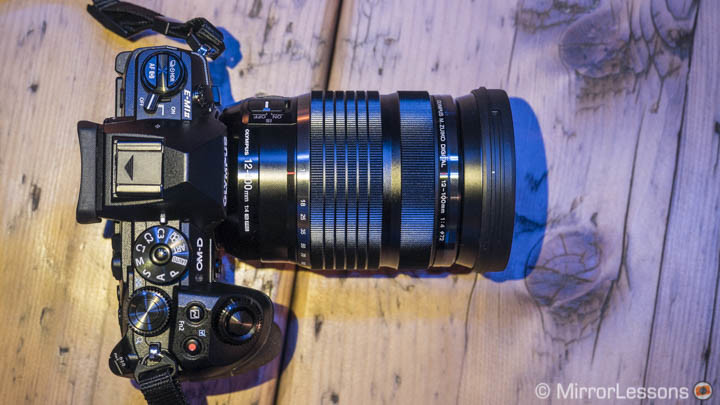Nope, we haven’t forgotten to talk about the new Olympus lenses introduced at Photokina. Though we had the chance to see them at the same time as the OM-D E-M1 II (hands-on articles here and here), we decided to share our findings in a separate article that I admit, has arrived a little later than I’d hoped!
Olympus introduced one affordable macro prime lens (the M.Zuiko 30mm f/3.5) and two new Pro lenses: the 25mm f/1.2 PRO and the 12-100mm f/4 PRO. As usual, you can find our hands-on Photokina video below followed by some thoughts.
M.ZUIKO DIGITAL ED 30mm f/3.5 Macro
This new lens is part of the Premium series and is very similar to the M.Zuiko 25mm f/1.8 and the M.Zuiko 45mm f/1.8 in terms of the build quality with its plastic barrel and metal mount. The lens is really tiny, just slightly smaller than the Lumix G 30mm f/2.8 Macro (the latter also has optical stabilisation).

The lens focuses fast with the E-M5 II that I used it on and the sharpness already seems excellent from f/3.5. Interestingly the lens has a higher magnification factor than the well-loved M.Zuiko 60mm f/2.8 Macro (1.25x vs 1). You can focus as close as 9.5cm which means that you can capture the details on a ring for example. The only thing to be aware of is that when you get really close, the lens inevitably casts a shadow on your subject, so a ring flash or similar accessory will be useful to have on hand.
I like the lens because it reminds us once again how small and light a Micro Four Thirds lens can be. The $300 price tag makes it an excellent choice for someone who wants to start experimenting with macro photography without investing too much.


M.ZUIKO DIGITAL ED 25mm f/1.2 PRO
There are plenty of valid zoom lenses for the system but more than any other, Micro Four Thirds excels at making high quality fast primes. I realised that myself when I started to use the M.Zuiko 75mm f/1.8 more than the Lumix 35-100mm f/2.8 for my work back in Italy when I was an event photographer. So naturally the newly announced 25mm f/1.2 PRO is excellent news and I hope it’s the beginning of a new f/1.2 series from Olympus.

The new 25mm fits into the Pro series and receives the same treatment as the other lenses (and feels as great as the other lenses too): an all-metal body with a dust, splash and freeze proof design, L-FN button and clutching focus ring. There is also a hyperfocal scale on the barrel.
The lens is definitely a large prime lens for the system but I don’t find it too heavy and I am sure it can be comfortable to use on a Pen F or E-M5 II as well.
The lens seemed really fast on the E-M1 mark II but performed admirably on the original E-M1 as well. A few shots taken in a rush during a big photo show like Photokina certainly won’t do justice to the lens but what I saw is very encouraging: sharp at f/1.2, creamy bokeh and the separation capabilities seem good as well. The lens has a minimum focus distance of 30cm.
The price is not cheap at all at $1200 but I am curious to find out how much the optical quality is deserving of it. I also wonder how big the difference will be between it and the Pana/Leica 25mm f/1.4. One thing I am already sure of is that the Olympus lens has a superior build quality!




M.ZUIKO DIGITAL ED 12-100mm f/4 IS PRO
The third lens was the charm, or if you prefer, the lens that surprised me the most. It is larger and heavier than the 12-40mm f/2.8 on paper but in the real world it doesn’t feel much bigger. I find it comfortable to use on the E-M1 and E-M5 II.

It has an equivalent 24-200mm field of view if we refer to the 35mm format and the constant aperture of f/4 is very welcome, though it will prove a little challenging in low-light conditions if you can’t use very slow shutter speeds. Otherwise the built-in optical stabilisation should work wonders combined with the sensor stabilisation of the E-M1, E-M1 II, Pen F and E-M5 II. Olympus claims 6.5 EV of compensation with the E-M1 II which has the most recent sensor shift hardware. I am also curious to test the optical stabilisation performance alone as the lens can be interesting for Panasonic users too.
The build quality is once again the same: it has a robust metal construction, weather proofing, a function button and a clutched focus ring. The zoom mechanism is not internal, so the lens extends by around 5cm. The minimum focus distance is 15cm at 12mm and 45cm at 100mm so the lens should prove a great companion for close-up shots.
[twentytwenty]


[/twentytwenty]
I have yet to test its optical quality to see its full potential but I am pretty sure the lens won’t disappoint. The price is $1300 which is not cheap once again.
- Olympus OM-D E-M1 mark II hands-on with video
- Olympus OM-D E-M1 mark II extra information and questions answered
- Photokina 2016 full coverage
The M.Zuiko 12-100mm f/4 sounds like a great high-quality all-purpose lens for travel photography, one of those lenses you’d never unmount from your camera unless you needed something faster like… the M.Zuiko 25mm f/1.2! Now that I think about it, these two could complement each other really well. (But our bank accounts might say otherwise!)
